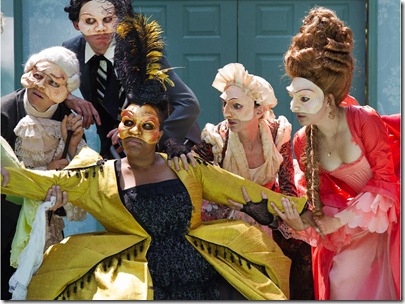Turcaret or The Financier. Commedia style changes the focus of the play.
Photo. Barb Gray
Highly influenced by Moliere’s witty, sharp and ironic criticism of French society’s many vices, Alain René Lesage follows in his footsteps, only he takes Moliere’s comedy even deeper into the dark side of human nature. In his famous classic “Turcaret” there is not a single positive character. The time when the King’s funds are exhausted and those close to the king scheme with his tax collectors to swindle the country’s treasury is a perfect moment for financiers to make remarkable fortunes. Turcaret is a representative of that new class – the “nouveau riche,” who acquired tremendous fortunes by various means – most of them illegal. What these new rich upstarts do not have is class or social prestige, so they are after any possible way to buy that last obstacle they face on their way to high society.
Lesage explores this desire for power and prestige embedded in humans, presuming that everybody is chasing the opportunity to overcome stumbling blocks to his or her goal. Big money combined with lack of everything else (social status, education, good taste, etc.) can attract only one kind of “admirer”: scoundrels of all kinds – greedy schemers, trained in the art of the swindle.
Everybody in this comedy is after something – the widowed, impoverished baroness is after money and romance; the rich financier is after respectability through a marriage into nobility; and the romantic (and penniless) chevalier, maids and valets plot for their gain. But, when the masks are finally off, reality plays the last act leaving everybody on the loosing end.
In this interpretation of the spirit of 18th century France and its many vices, Odyssey Theatre achieves partial success. Marie-Nathalie Locoursière’s choreography is charming. It works especially well for changing the set, making it part of the natural flow of the play. A big “bravo’ goes to Almut Ellinghuas for well-designed masks – the details of which stem from the text. They are refined masks covering an endless reservoir of malice underneath.
The problem is that the focus is completely shifted. Instead of developing characters – in this case representing evils of the time – the actors concentrated on the choreography. As a consequence, the depth of the ideas is lacking due to the uniformness of the protagonists. As the masks cover the faces, the actors cannot show ugliness, stupidity or slyness with the facial expressions. They are limited to their body expressions due to the choreography, which portrays deception through unnatural movement. Thus, this leaves the artist only one vehicle: the voice. But, having everybody exaggerate and shout with and without legitimate reason does not help. The variations in the voice are almost non-existent, hence the needed atmosphere, and especially the rigid class distinctions so essential for that time, are altogether missed. A different tone, a slightly individual touch to the movements, a wisely chosen pause could make all the difference. The only exception to this is Allana Bale in the dual role of the maids (Marine and Lisette). More often than not, her voice carries a tone that distinguishes her from the rest and which depicts the mood or intent of the moment. In all her acting she sounds different and closer to the author’s humorous style in which he highlights the problematic of greed.
The audience reception to the first performance of the “Financier” was mild. Still, regardless of some misgivings, it was an interesting attempt to attack a classical comedy.
Financier runs from July 24 to August 24 in Strathcona Park.
Production Odyssey Theatre – Theatre Under the Stars series
The Financier
by Alain René Lesage
